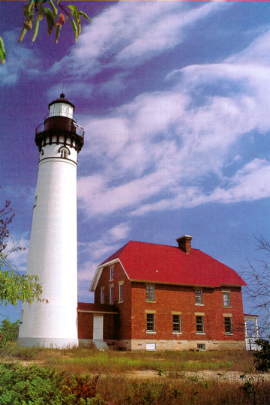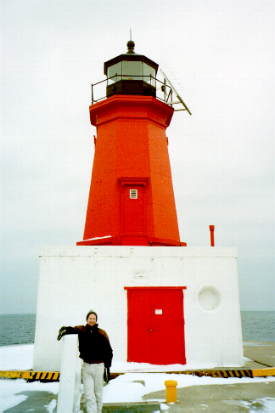Lighthouses of the Great Lakes
by Andreas Jordahl Rhude
The lighthouse. It conjures up images of the heyday of maritime history. Once the “road signs” of the seas, they have become an endangered, if not threatened, species. Modern radar and GPS have made the lighthouse obsolete for commercial shipping. They do, however, continue to serve a function for smaller craft. The Great Lakes have a rich maritime history and lighthouses have played a vital role in the success of human development of the region.
As a navigational aid, lighthouses became the lifelines of water transportation. Movement of people and merchandise by water was much easier and less costly than overland travel during the early era of American expansion. Therefore, making water travel as safe as possible became a social and economic necessity. Lighthouses became an integral part of this development.


Arusable Point LIghthouse, Grand Marais, MI
The first navigational “lighthouses” were bonfires built on shore to guide ships back home. The first actual lighthouse may have been built on the island of Pharos at the entry to Alexandria harbor, Egypt. It was built by order of Emperor Ptolemy and it went into service in 285 BC. The Colossus of Rhodes (270 BC) may also have served as a functional lighthouse. Romans built at least thirty substantial lights in the Mediterranean Sea by the third century AD.
The first major lighthouse in America dates to 1716 at Little Brewster Island in Boston harbor. The redcoats (British) destroyed it in June 1776 while retreating from the Boston area. The foundation, however, served as base for a new tower built in 1783. According to the book Legendary Lighthouses by Grant and Jones, this is the last remaining lighthouse having a manned keeper.
The first Great Lakes lighthouse was put into service in 1818 at Fort Niagara on Lake Ontario in New York state. Lake Superior obtained its first lighthouses in 1849, one at Whitefish Point and another at Copper Harbor — both in Michigan’s Upper Peninsula. By 1852 there were 76 lighthouses on the Great Lakes. Of the 331 lighthouses in America at that time, an impressive twenty-two percent were on the Great Lakes.
Many Great Lakes lighthouses still stand; others have been left to decay and crumble. The Green Island lighthouse, in Lake Michigan’s Green Bay, is one that has crumbled. Many of my own early childhood boating memories, were trips out to Green Island to explore the lighthouse ruin. I will never forget the thousands of seagulls flocking around the remaining bones of this building as our family inched our way to get a closer look at the hulk.
One of the best known Lake Superior lighthouses is the Split Rock Light. Located on the north shore about 45 miles northeast of Duluth, it served as a beacon for important shipping traffic from 1910 until it was decommissioned in 1969. The lighthouse sits atop a rugged cliff, 120 feet above the lake. Construction of the light at Split Rock was authorized after a notorious Lake Superior storm in November 1905. Twenty-nine ships were damaged, two sinking off the Split Rock point. One of these sunken wrecks is still visible, with the proper conditions, from the cliffs at Split Rock. I have canoed right over the hulk on one of those rare, placid Lake Superior days. Today, Split Rock is part of a state park and historic site of the Minnesota Historical Society. The lighthouse keeper’s house and fog signal buildings have been restored to their 1920s condition and they are open to the public. It is one of the most visited of any lighthouse in the nation. A museum operated by the Minnesota Historical Society sits adjacent to the lighthouse. It has wonderful interpretive and hands-on interactive displays.
The Apostle Islands, off Wisconsin’s north coast of Lake Superior, are home to several restored lighthouses. Between 1857 and 1891 six lighthouses were built in the Apostles. All are still in use, although each has been automated. The Sand Island light on the western most island of the Apostles, has been restored and it is open to the public. It is a brownstone building and tower, erected in 1881. It is constructed from the same sandstone quarried on this and other Apostle Islands, brownstone that was shipped across the country to build many cities. Today, volunteers give tours during the summer season. Like keepers of yesteryear, they live at this isolated site. For some it is a welcome reprieve from their hectic 1990s lifestyles.
Raspberry Island lighthouse is a white clapboard structure built in 1863. It has a fifth order lens. The Coast Guard placed a solar powered optic lens in the tower in 1957, ending its nearly century of manned service. Both Sand and Raspberry Island lights are open to the public. Access, is, however, a bit limited, as they are reached only by boat.
Isle Royale, in Lake Superior, has two lighthouses. The 130 foot tall Rock of Ages light was completed in 1908. It is located several miles offshore of the southwestern edge of the island. The huge 700,000 candle power, second order Frensel lens was removed in 1985. It is on display at Isle Royale National Park. A solar powered lens has been installed to take place of the original light.
In 1933 the USS George M. Cox went aground in a fog near Rock of Ages. The 125 passengers and crew were rescued by the light keepers, spending the night huddled on the tower’s spiral stairway.
 Andreas at the lighthouse on Menomonie River
Andreas at the lighthouse on Menomonie River
The Passage Island light is on the northeast end of Isle Royale. She is the northern most American lighthouse on the Great Lakes. She is used to guide vessels into the port of Thunder Bay, Ontario. This light was built in 1882.
A unique Lake Superior light is the Stannard Island Light. She is located fifty miles off shore of Marquette, Michigan. In 1835 the sailing schooner John Jacob Astor “discovered” a mile long reef just beneath the surface of the water. The light is named in honor of Charles Stannard, captain of the ill-fated Astor. In the midst of a major shipping lane, a lighthouse was completed in 1882. It took years of planning and $300,000.00 to construct this isolated light. A huge sum for the 1880s!
While most lighthouses are far removed from civilization, the Stannard Island light is uniquely so. It is just a small, man-made island, fifty miles from the nearest land. Psychological effects on the keepers were intense. One Coast Guard seaman had to be removed in a straight jacket. Another threatened to swim for shore as he was so desperate. The lighthouse became automated in 1961. During the retrofit, an explosion killed one of the three seamen on duty. The explosion and fire destroyed the living quarters and machine room. The tower, still standing, withstood the blast.
From my childhood home I could see several Lake Michigan lighthouses. The Green Island light, several Door County lights, and the Peshtigo Point light were a few. Just north of Fish Creek in Door County, Wisconsin is the Peninsula State Park. The Eagle Bluff lighthouse, built in 1868, still shines. Restored by the local historical society, she is part of the state park. At ten, Door County can boast that she has more lighthouses than any county in the nation.
Each May a two-day event, the Door County Lighthouse Walk, celebrates the navigational heritage of the peninsula. Special access is made to all the county’s lighthouses during the celebration. Normally, only Eagle Point lighthouse in Peninsula State Park is open to the public. Lighthouses have been the welcome beacons to seafarers for centuries. As technology has progressed the lighthouse has become outmoded and obsolete. Many have gone the way of the dinosaur. Many are still in dire straights, such as the Cape Hatteras light in North Carolina, which is threatened by the sea. Its survival has now been assured; a ten million dollar effort has begun to move the 208 foot tall tower further inland from the sea. As of this printing, the move was successfully completed. The value of these magnificent structures is undeniable when you consider what it took, in both dollars and labor, to move a 5,000 ton structure a distance of 1200 (or so) feet.
A number have been painstakingly maintained and restored. It is these lighthouses, still available to the public, that hearken back to a by-gone era — one of adventure and daring, when the waterways were the best means of travel, communication, and commerce. With their passing, a bit of our maritime heritage is lost. Who amongst us has not warmly looked upon a painting, photograph of a lighthouse and said to oneself, “That’s so idyllic I’d like to be there right now.”?
Several lighthouse celebrations are held annually in the Apostle Islands and in Wisconsin’s Door County. The Fourth Annual Apostle Islands Lighthouse Celebration takes place September 8-29, 1999. For additional information, telephone (800) 779-4487.

